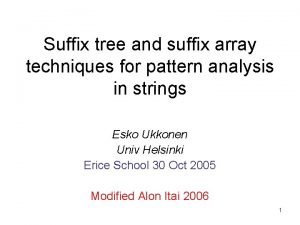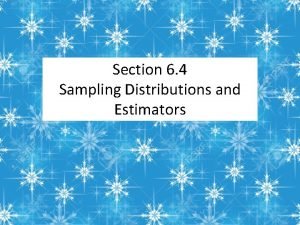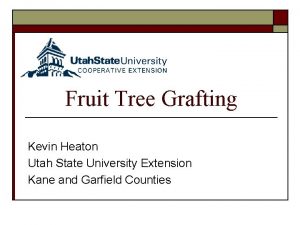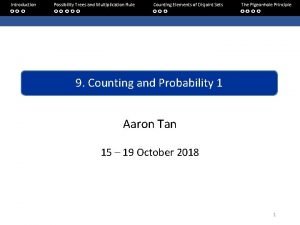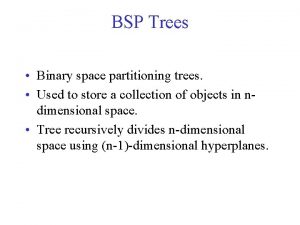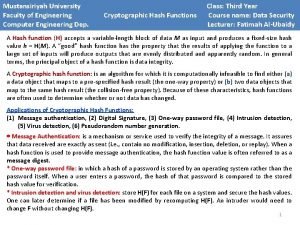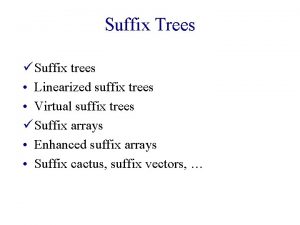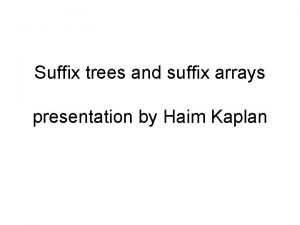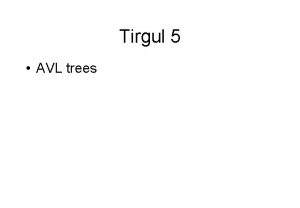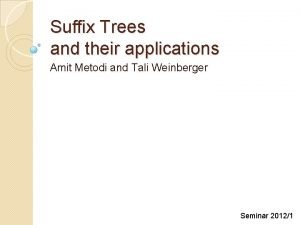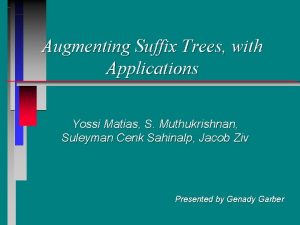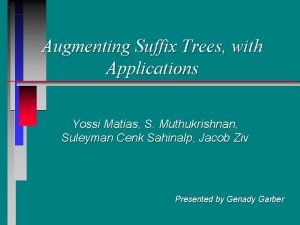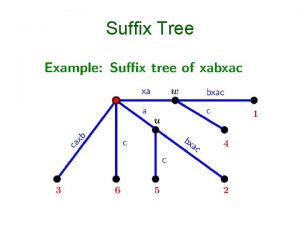Selected Applications of Suffix Trees 1 Reminder suffix







![Compute ms(i) in order base case: For ms(1), match T[1. . . m] from Compute ms(i) in order base case: For ms(1), match T[1. . . m] from](https://slidetodoc.com/presentation_image_h2/d2a893e54b22a8ad46ca747ee92d467a/image-8.jpg)




![Basic idea • Suppose the text S[1. . . i-1] has been represented (perhaps Basic idea • Suppose the text S[1. . . i-1] has been represented (perhaps](https://slidetodoc.com/presentation_image_h2/d2a893e54b22a8ad46ca747ee92d467a/image-13.jpg)









![Claim 1 Assume: – The compaction has been done for S[1. . . i-1]. Claim 1 Assume: – The compaction has been done for S[1. . . i-1].](https://slidetodoc.com/presentation_image_h2/d2a893e54b22a8ad46ca747ee92d467a/image-23.jpg)
![Suppose we had a suffix tree for S[1. . . i-1] with cv values Suppose we had a suffix tree for S[1. . . i-1] with cv values](https://slidetodoc.com/presentation_image_h2/d2a893e54b22a8ad46ca747ee92d467a/image-24.jpg)

















































- Slides: 73

Selected Applications of Suffix Trees 1

Reminder – suffix tree Suffix tree for string S of length m: • rooted directed tree with m leaves numbered 1, . . . , m. • each internal node, except the root, has at least 2 children. • each edge labeled with a nonempty substring of S. • edges out of a node begin with different characters. • path from the root to leaf i spells out suffix S[i. . . m]. 2

Reminder – suffix tree (continued) • Each substring a of S appears on some unique path from the root. • If a ends at point p, the leaves below p mark all its occurrences. a occurs in S starting at position j a is a prefix of S[j. . . m] a labels an initial part of the path from the root to leaf j. 3

Example: S=xabxa$ 1 2 3 4 5 6 x b a x a a $ v b $ x a $ 3 4 6 5 b 2 $ a $ 4 1

Exact string matching Find all occurrences of pattern P in text T. • Build suffix tree for T O(m) (Ukkonen). • Match P along a path from the root O(1) per character (finite alphabet) O(n) total. • If P fully matches a path, then the leaves below mark all starting positions of P in T O(k) where k = number of occurrences. 5

Matching Statistics • ms(i) – the length of the longest substring of T starting at position i that matches a substring somewhere in P. • example: T = abcxabcdex, P = wyabcwzqabcdw ms(1)=3, ms(5)=4. • There is an occurrence of P starting at position i of T iff ms(i)=|P|. 6

Goal: Compute ms(i) for each position i in T, in O(m) total time, using only a suffix tree for P. • Naive way: match T[i. . . m] starting from the root. more than O(m) total. Using suffix links: • Build suffix tree for P (Ukkonen) and keep suffix links. • suffix link: pointer from internal node v with path-label xa to node s(v) with path-label a. (x character, a substring) 7
![Compute msi in order base case For ms1 match T1 m from Compute ms(i) in order base case: For ms(1), match T[1. . . m] from](https://slidetodoc.com/presentation_image_h2/d2a893e54b22a8ad46ca747ee92d467a/image-8.jpg)
Compute ms(i) in order base case: For ms(1), match T[1. . . m] from the root. general case: Suppose the matching path for ms(i) ended at point b, then for ms(i+1): • Let v be the first internal node at or above b. • If there is no such v – search from the root. • Otherwise – follow the suffix link from v to s(v) and search from s(v). path_label(v)=xa is a prefix of T[i. . . m] path_label(s(v))=a is a prefix of T[i+1. . . m]. 8

skip / count • Let b denote the string between node v and point b. • substring xab in P matches a prefix of T[i. . . m]. • substring ab in P matches a prefix of T[i+1. . . m]. • Traverse the path labeled b out of s(v) using skip/count trick (time proportional to number of nodes on the path). • From the end of b, match single characters (starting with the first character that didn’t match for ms(i)). 9

Time analysis In the search for ms(i+1): • back up at most one edge from b to v O(1). • traverse suffix link from v to s(v) O(1). • traverse a b-path from s(v) in time proportional to the number of nodes on it O(m) total. • perform additional comparisons starting with the first character that didn’t match for ms(i) O(m) total. 10

Ziv-Lempel data compression 11

Definitions For any position i in string S of length m: • Priori - longest prefix of S[i. . . m] that occurs as a substring of S[1. . . i-1]. • li - length of Priori. • si - starting position of the left-most copy of Priori (li>0). Example: S = abaxcabaxabz, Prioir 7 = bax, l 7 = 3, s 7 = 2. • Copy of Priori starting at si is totally contained in S[1. . . i-1]. 12
![Basic idea Suppose the text S1 i1 has been represented perhaps Basic idea • Suppose the text S[1. . . i-1] has been represented (perhaps](https://slidetodoc.com/presentation_image_h2/d2a893e54b22a8ad46ca747ee92d467a/image-13.jpg)
Basic idea • Suppose the text S[1. . . i-1] has been represented (perhaps in compressed form) and li>0. • Then Priori need not be explicitly represented. • The pair (si, li) points to an earlier occurrence of Priori. • Example: S = abaxcabaxabz (2, 3) 13

Compression algorithm (outline) i : = 1 Repeat compute li and si if li > 0 then output (si, li) i : = i + li else output S(i) i : = i + 1 Until i > n 14

Examples S 1 = a a b a c b (1, 1) c a b a x (1, 3) x a b (1, 2) z z S 2 = ab ab abababab ab(1, 2)(1, 4) (1, 8) (1, 16) S = (ab)k compressed representation is O(log k) 15

Decompress • Process the compressed string left to right. • Any pair (si, li) in the representation points to a substring that has already been fully decompressed. 16

Computing (si, li) • The algorithm does not request (si, li) for any position i already in the compressed part of S. compute li and si if li > 0 then output (si, li) i : = i + li • For total O(m) time, find each requested pair (si, li) in O(li) time. 17

Implementation using suffix tree (1) Before compression: • Build a suffix tree T for S. • For each node v, compute cv : – the smallest leaf index in v’s subtree. – the starting position of the leftmost copy of the substring that labels the path from the root to v. • O(m) time. 18

Implementation using suffix trees (2) root computing (si, li): a |a| + cv ≤ i p m i. . . S[ v ] cv i |a| leaf i 19

Implementation using suffix trees (3) • To compute (si, li), traverse the unique path in T that matches a prefix of S[i. . . m]: – Let: p - current point, v - first node at or below p. – Traverse as long as: string_depth(p) + cv ≤ i. – At the last point p of traversal: li = string_depth(p), si = cv. • O(li) time. 20

Example S = abab i=1 li=0 a 1 2 3 4 5 6 7 8 i=2 li=0 b a b cv=2 b b cv=2 $ 2 21 b v 1 a b a a $ $ i=5 li=4 cv=1 (1, 4) cv=1 v 2 a $ cv=2 string depth=1 b a i=3 li=2 cv=1 (1, 2) cv=1 b $ a $ $ 4 6 8 7 5 3 cv=1 b $ 1

Online version • Compress S as it is being input one character at a time. • Possible since S[1. . . i-1] is known before computing si, li. • Implementation: build suffix tree online. Ukkonen’s algorithm: – In phase i, build implicit suffix tree Ti for prefix S[1. . . i]. 22
![Claim 1 Assume The compaction has been done for S1 i1 Claim 1 Assume: – The compaction has been done for S[1. . . i-1].](https://slidetodoc.com/presentation_image_h2/d2a893e54b22a8ad46ca747ee92d467a/image-23.jpg)
Claim 1 Assume: – The compaction has been done for S[1. . . i-1]. – Implicit suffix tree Ti-1 for S[1. . . i-1] has been built. – cv values are given for each node v in Ti-1. Then (si, li) can be obtained in O(li) time. 23
![Suppose we had a suffix tree for S1 i1 with cv values Suppose we had a suffix tree for S[1. . . i-1] with cv values](https://slidetodoc.com/presentation_image_h2/d2a893e54b22a8ad46ca747ee92d467a/image-24.jpg)
Suppose we had a suffix tree for S[1. . . i-1] with cv values We could find (si, li) in O(li) time. li = string_depth(p) root si = cv S(i) S(i+1). . . p S(k-1) c S(k) v 24

The missing leaves in the implicit suffix tree are not needed. root S(i) . . . p S(k-1) p c S(k) v $ S(h) S(i-1) S(j). . . S(i-1) leaf j leaf h 25 . . . h<j leaf h

Claim 2 cv values for all implicit suffix trees can be computed in total O(m) time. • In Ukkonen’s algorithm: – Only extension rule 2 updates cv values. – Whenever a new internal node v is created by splitting an edge (u, w): cv cw. – Whenever a new leaf j is created: cj j. constant update time per new node. 26

Updating cv values new leaf and new node: new leaf: root S(j) u S(i) S(i+1) v c 1 j 27 S(i+1) c 2 S(i) v c w j

Online algorithm • Base case: output S(1) and build T 1. • General case: Suppose S[1. . . i-1] has been compressed and Ti-1 with cv values has been constructed. – – – Match S(i), S(i+1), . . . along a path from the root in Ti-1. Let S(k) be the first that doesn’t match. Find (si, li). If li = 0, output S(i) and build Ti with cv. If li > 0, output (si, li) and build Ti, . . . , Tk-1 with cv. • Total time: O(m). 28

Maximal Repetitive Structures 29

Maximal Pair • A maximal pair in string S: A pair of identical substrings a and b in S s. t. the character to the immediate left (right) of a is different from the character to the immediate left (right) of b. • Extending a and b in either direction would destroy the equality of the two strings. • Example: S = xabcyiiizabcqabcyrxar 30

Maximal Pair (continued) • Overlap is allowed: S = cxxaxxaxxb cxxaxxaxxb • To allow a prefix or suffix of S to be part of a maximal pair: S #S$ (#, $ don’t appear in S). Example: #abcxabc$ 31

Maximal Repeat • A maximal repeat in string S: A substring of S that occurs in a maximal pair in S. • Example: S = xabcyiiizabcqabcyrxar maximal repeats: abc, abcy, . . . 32

Finding All Maximal Repeats In Linear Time • Given: String S of length n. • Goal: Find all maximal repeats in O(n) time. • Lemma: Let T be a suffix tree for S. If string a is a maximal repeat in S, then a is the path-label of an internal node v in T. 33

Proof – by def. of maximal repeat S = xabcyiiizabcqabcyrxar root a a b c v y 34 q

Conclusion • There can be at most n maximal repeats in any string of length n. • Proof: by the lemma, since T has at most n internal nodes. 35

Which internal nodes correspond to maximal repeats? • The left character of leaf i in T is S(i-1). • Node v of T is left diverse if at least 2 leaves in v’s subtree have different left characters. • A leaf can’t be left diverse. • Left diversity propagates upward. 36

Example: S = #xabxa$ 12 3 456 max imal x b a $ b x $ x a $ 3 a 37 left diverse at a x a repe 6 a 5 2 x x $ a $ 4 b 1 #

Theorem The string a labeling the path to an internal node v of T is a maximal repeat v is left diverse. 38

Proof of • Suppose a is a maximal repeat • It participates in a maximal pair • It has at least two occurrences with distinct left characters: xa, ya, x y • Let i and j be the two starting positions of a. Then leaves i and j are in v’s subtree and have different left characters x, y. • v is left diverse. 39

Proof of • Suppose v is left diverse there are substrings xap and yaq in S, x y. • If p q a’s occurrences in xap and yaq form a maximal pair a is a maximal repeat. • If p=q since v is a branching node, there is a substring zar in S, r p. If z x It forms a maximal pair with xap. If z y It forms a maximal pair with yap. In either case, a is a maximal repeat. 40

Proof of (continued) root Case 1: Case 2: root a a v p… left char x 41 v r. . . q… left char y left char z left char x p. . . left char y

Compact Representation • Node v in T is a frontier node if: – v is left diverse. – none of v’s children are left diverse. • Each node at or above the frontier is left diverse. • The subtree of T from the root down to the frontier nodes is a compact representation of the set of all maximal repeats of S. • Representation in O(n) though total length may be larger. 42

Linear time algorithm • Build suffix tree T. • Find all left diverse nodes in linear time. • Delete all nodes that aren’t left diverse, to achieve compact representation: 43

finding all left diverse nodes in linear time • Traverse T bottom-up, recording for each node: – either that it is left diverse – or the left character common to all leaves in its subtree. • For each leaf: record its left character. • For each internal node v: – If any child is left diverse v is left diverse. – Else If all children have a common character x record x for v. – Else record that v is left diverse. 44

Finding All Maximal Pairs In Linear Time • Not every two occurrences of a maximal repeat form a maximal pair. Example: S = xabcyiiizabcqabcyrxar • There can be more than O(n) maximal pairs. • The algorithm is O(n+k) where k is the number of maximal pairs. 45

General Idea For each node u and character x: keep all leaf numbers below u whose left character is x. root To find all maximal pairs of a: a For each character x, form the cartesian product of the list for x at v 1 with every list for a character x at v 2. v p… q… v 1 leaf i left char x 46 v 2 leaf j left char y

The Algorithm • Build suffix tree T for S. • Record the left character of each leaf. • Traverse T bottom-up. • At each node v with path-label a: – Output all maximal pairs of a: cartesian product of lists (u, x) and (u’, x’) for each pair of children u u’ and pair of characters x x’. – Create the lists for node v by linking the lists of v’s children. 47

Time Analysis • Suffix tree construction O(n). • Bottom-up traversal including all list-linking O(n). • All cartesian product operations O(k), where k is the number of maximal pairs. • Total O(n+k). 48

Finding All Supermaximal Repeats In Linear Time • supermaximal repeat: a maximal repeat that isn’t a substring of any other maximal repeat. • Example: S = xabcyiiizabcqabcyrxar abcy is supermaximal, abc isn’t. • Theorem: A left diverse internal node v in the suffix tree for S represents a supermaximal repeat iff – all of v’s children are leaves – and each has a distinct left character 49

Longest Common Extension 50

Longest common extension problem Preprocess strings S 1 and S 2 s. t. the following queries can be computed in O(1) time each: • Given index pair (i, j), find the length of the longest substring of S 1 starting at position i that matches a substring of S 2 starting at position j. S 1: . . . abcdzzz. . . S 2: . . . abcdefg. . . j 51 i

Solution Preprocess: O(|S 1|+|S 2|) • Build generalized suffix tree T for S 1 and S 2. • Preprocess T for constant-time LCA queries. • Compute string-depth of every node. To answer query (i, j): O(1) • Find LCA node v of leaves corresponding to suffix i of S 1 and suffix j of S 2. • Return string-depth(v). 52

Tandem Repeats 53

Definition tandem repeat: a string a that can be written as a = bb, where b is a substring. s=xababy a b|a b b = ab a b|a b b a|b a b = ba b a|b a b = abab a b|a b note: b is not required to be of maximal length. 54

Finding all tandem repeats – simple solution For each feasible pair of start position i and middle position j: • Perform a longest common extension query from i and j. • If the extension from i reaches j or beyond, (i, j) defines a tandem repeat. 1. . . i. . . j-1 j. . . 2 j-i-1 2 j-i. . . n j-i 55 j-i

Time analysis • Preprocess for longest common extension: O(n). • O(n 2) feasible pairs, O(1) time to check each one. • O(n 2) total. 56

Finding all tandem repeats – faster solution • Due to Landau & Schmidt. • O(nlogn + z) time. • z = total number of tandem repeats in S. • z can be as large as Ө(n 2). • Example: all n characters are the same. • In practice, z is expected to be smaller. 57

Divide and conquer Let h = n/2. • Find all tandem repeats contained entirely in the first half of S (up to h). • Find all tandem repeats contained entirely in the second half of S (after h). • Find all tandem repeats where the first copy contains h. • Find all tandem repeats where the second copy contains h. 58

Solution of subproblems • 1 and 2 solved recursively. • 3 and 4 symmetric to each other. • Remains to show: solution for 3. 59

Solution for subproblem 3 • For each l = 1, . . . , h, find all tandem repeats of length exactly 2 l whose first copy contains h. l 2 l 1 X 1 l 1 Y 1 X 2 Y 2 . . . h-1 h q-1 q l 60

Algorithm for fixed l 1. Let q = h+l. 2. Compute longest common extension from h and q. Let l 1 denote its length. 3. Compute longest common extension from h-1 and q-1 in reverse direction. Let l 2 denote its length. 4. There is a tandem repeat of length 2 l whose first copy contains h iff l 1 1 and l 1 + l 2 l. 61

Output for fixed l 5. If the condition holds, output starting positions: Max(h-l 2 , h-l+1), . . . , Min(h+l 1 -l , h). l 1 l 2 h-l 2 h+l 1 -l h -l 62 h+l-l 2 h+l 1 q

Time analysis • For fixed l: – O(1) longest common extension queries. • For subproblem 3 on a string of length n: – O(n) longest common extension queries. • Entire algorithm on a string of length n: – Let T(n) denote the number of longest common extension queries for a string of length n. T(n) = 2 T(n/2) + 2 n T(n) = O(nlogn) – Including output: O(nlogn + z) total. 63

Inexact Matching 64

The k-mismatch problem • Given: pattern P, text T, fixed number k. • k-mismatch of P: a |P|-length substring of T that matches at least |P|-k characters of P (i. e. it matches P with at most k mismatches). • The k-mismatch problem: Find all k-mismatches of P in T. 65

Example P = bend T = abentbananaend k=2 T contains three 2 -mismatches of P: aben tbananaend bend 1 -mismatch 2 -mismatch 66 1 -mismatch

Solution • Notation: |P|=n, |T|=m, k independent of n and m (k<<n). • General idea: – For each position i in T, determine whether a k-mismatch of P begins at position i. – To do this efficiently: successively execute up to k+1 longest common extension queries. – A k-mismatch of P begins at position i iff these extensions reach the end of P. 67

solution (continued) 1 2 4 n P T i query 1 68 i+3 query 2 query 3

Algorithm for index i 1. 2. 3. 4. 69 j 1 i’ i count 0 Compute the length l of the longest common extension starting at positions j of P and i’ of T. if j+l=n+1 then a k-mismatch of P occurs in T starting at i; stop. if count<k then count+1 j j+l+1 i’ i’+l+1 go to step 2. else, a k-mismatch of P does not occur in T starting at i; stop.

Time Analysis • Preprocessing of T and P for longest common extension queries O(m). • For each index i=1, . . . , m-n+1 of T, up to k+1 longest common extension queries O(k) per index O(km) total. • Total O(km) time. 70

k-mismatch tandem repeat • definition: tandem repeat in which the two copies differ by at most k mismatches. • example: axab|aybb • goal: find all k-mismatch tandem repeats. • simple solution: For each feasible pair of starting position i and middle position j, check if S[i. . . j-1] and S[j. . . 2 j-i-1] match with at most k mismatches. O(kn 2) • 71 faster solution exists: O(knlog(n/k)+z).

faster k-mismatch tandem repeats • O(knlog(n/k)+z) • same divide and conquer algorithm. • subproblem 3 for fixed l: find all k-mismatch tandem repeats of length 2 l whose first copy contains h. • let q = h+l. • run k successive longest common extension queries forward from h and q. mark every mismatch with ->. • run k successive longest common extension queries backward from h-1 and q-1. mark every mismatch with < • position t in [h+1, q] is a middle position of a k-mismatch tandem repeat iff the number of -> mismatches in positions h, . . . , t-1 plus the number of <- mismatches in positions t, . . . , q-1 is ≤ k. 72

faster k-mismatch tandem (continued) • accee|abcde|accdd h t q • calculate sums only for positions with arrows, to get intervals of legal midpoints. • O(k) time per fixed l, and any l ≤ k need not be checked. 73
 I693 reminder letter
I693 reminder letter Fanny girden
Fanny girden Adjectives for reminder
Adjectives for reminder Stir you up by way of reminder
Stir you up by way of reminder Pda reminder 1
Pda reminder 1 Growth mindset crumpled paper activity
Growth mindset crumpled paper activity Reminder symbol
Reminder symbol Phytel appointment reminder
Phytel appointment reminder As a quick reminder...adenine always pairs with
As a quick reminder...adenine always pairs with Binder reminder
Binder reminder Pda reminder 1
Pda reminder 1 What does it mean
What does it mean Sql reminder
Sql reminder Thanks for the reminder.
Thanks for the reminder. Critical reminder
Critical reminder Cohesive essay
Cohesive essay Npda
Npda C++ suffix tree
C++ suffix tree K selected species survivorship curve
K selected species survivorship curve Among 420 randomly selected employees
Among 420 randomly selected employees Selected response tasks
Selected response tasks Ann arbor mi population pyramid
Ann arbor mi population pyramid Selected response questions
Selected response questions K selection r selection
K selection r selection Example of r selected species
Example of r selected species Gwen harwood: selected poems
Gwen harwood: selected poems Parallel communication interface
Parallel communication interface Not only the students but also their instructor
Not only the students but also their instructor Words images objects qualitative or quantitative
Words images objects qualitative or quantitative R-selected species
R-selected species Weights of the backpacks of first graders on a school bus
Weights of the backpacks of first graders on a school bus Type of data collected in quantitative research
Type of data collected in quantitative research Dreamweaver php tutorials
Dreamweaver php tutorials How can you add a new costume of sprite
How can you add a new costume of sprite Playstation | congratulations, you've been selected!
Playstation | congratulations, you've been selected! Vba listbox selected item value
Vba listbox selected item value Naming compounds
Naming compounds Word basic
Word basic K selected species survivorship curve
K selected species survivorship curve Three randomly selected households are surveyed 2 6 7
Three randomly selected households are surveyed 2 6 7 Debunk
Debunk Utah state extension fruit trees
Utah state extension fruit trees How do trees respire
How do trees respire Life is older older than the trees
Life is older older than the trees Palm trees
Palm trees Possibility trees and the multiplication rule
Possibility trees and the multiplication rule Hypernym definition
Hypernym definition Similarities between coniferous and deciduous trees
Similarities between coniferous and deciduous trees The tale of 3 trees
The tale of 3 trees Www.enotes.com
Www.enotes.com Short truth table
Short truth table Fat trees
Fat trees Bsp tree
Bsp tree Venn diagram of coniferous and deciduous trees
Venn diagram of coniferous and deciduous trees The bean trees quiz
The bean trees quiz 50 year old bonsai tree
50 year old bonsai tree Random survival forest python
Random survival forest python Planting more trees is called
Planting more trees is called Biological classification pogil answers model 4
Biological classification pogil answers model 4 What is data and process modeling
What is data and process modeling Bartek tree
Bartek tree His shadow shouts on a nightmare scream meaning
His shadow shouts on a nightmare scream meaning Java collections tree
Java collections tree Density estimation trees
Density estimation trees The definition of taiga
The definition of taiga Tass 1 trees
Tass 1 trees Expression trees
Expression trees Supply chain network design decisions include
Supply chain network design decisions include Fenwick tree
Fenwick tree How is sassafras's trees roots correctly written?
How is sassafras's trees roots correctly written? 2-3 trees
2-3 trees The trees by philip larkin summary
The trees by philip larkin summary Two trees in the garden
Two trees in the garden Trees in korea
Trees in korea

















